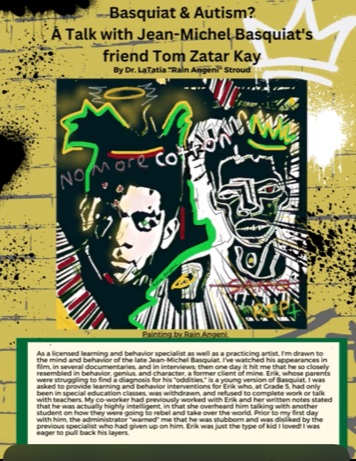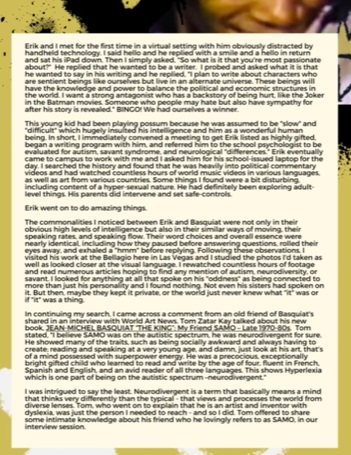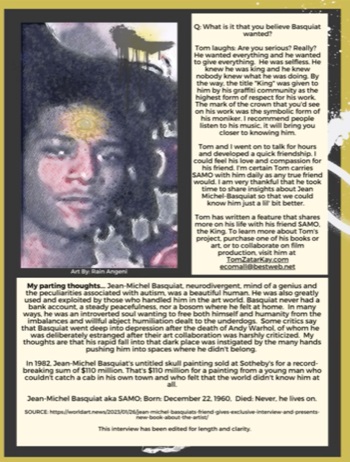
Black Tribe Magazine

Black Tribe Magazine
These beings will have the knowledge and power to balance the political and economic structures in the world. I want a strong antagonist who has a backstory of being hurt, like the Joker in the Batman movies. Someone who people may hate but also have sympathy for after his story is revealed." BINGO! We had ourselves a winner. This young kid had been playing possum because he was assumed to be "slow" and "difficult" which hugely insulted his intelligence and him as a wonderful human being. In short, I immediately convened a meeting to get Erik listed as highly gifted, began a writing program with him, and referred him to the school psychologist to be evaluated for autism, savant syndrome, and neurological "differences."
The commonalities I noticed between Erik and Basquiat were not only in their obvious high levels of intelligence but also in their similar ways of moving, their speaking rates, and speaking flow. Their word choices and overall essence were nearly identical, including how they paused before answering questions, rolled their eyes away, and exhaled a "hmm" before replying. Following these observations, I visited his work at the Bellagio here in Las Vegas and I studied the photos I'd taken as well as looked closer at the visual language. I rewatched countless hours of footage and read numerous articles hoping to find any mention of autism, neurodiversity, or savant. I looked for anything at all that spoke on his "oddness" as being connected to more than just his personality and I found nothing. Not even his sisters had spoken on it.
But then, maybe they kept it private, or the world just never knew what "it" was or if "it" was a thing. In continuing my search, I came across a comment from an old friend of Basquiat's shared in an interview with World Art News. Tom Zatar Kay talked about his new book, JEAN-MICHEL BASQUIAT “THE KINGâ€: My Friend SAMO – Late 1970-80s. Tom stated, "I believe SAMO was on the autistic spectrum, he was neurodivergent for sure. He showed many of the traits, such as being socially awkward and always having to create; reading and speaking at a very young age, and damn, just look at his art, that’s of a mind possessed with superpower energy. He was a precocious, exceptionally bright gifted child who learned to read and write by the age of four, fluent in French, Spanish and English, and an avid reader of all three languages. This shows Hyperlexia which is one part of being on the autistic spectrum –neurodivergent."
I was intrigued to say the least. Neurodivergent is a term that basically means a mind that thinks very differently than the typical - that views and processes the world from diverse lenses. Tom, who went on to explain that he is an artist and inventor with dyslexia, was just the person I needed to reach - and so I did.
Tom offered to share some intimate knowledge about his friend who he lovingly refers to as SAMO, in our interview session.
Q: Tom, so you believe Basquiat was on the Autism Spectrum? v Tom: Oh, this was no secret. Everyone in our circle knew it. I called him SAMO. We all called him SAMO. SAMO is short for a phrase he'd often say when asked about life or some weed he was smoking- "Same old shit." Those of us who were friends, and he had very few, knew him. It was common knowledge that he was neurodivergent. There were autistic behaviors. Most people believed his oddness was from chronic weed smoking or drugs but actually SAMO didn't like weed even though he occasionally indulged. I knew SAMO before the fame, when he was homeless, painting on walls and producing and recording music with his band, "Gray." The movies and some of the documentaries got him wrong and limited who SAMO really was. Early on, he definitely struggled. He'd sell himself for money. And, even after the fame, Andy Warhol was really using him in the same way. I don't believe he was a real friend. With the notoriety came the drugs that people would pay him with instead of money for his art. SAMO eventually became a heavy user of opium and opiates. He shot-up heroin. Many, many times we'd try to get him help and into treatment, but he wouldn't go, or he'd leave. He would say, "I like the way it makes me feel. It helps me create." It's my thought that heroin allowed him to survive. SAMO was a loner who worked alone and could be quite harsh to those he didn't know or care for. He always had the incessant need to write, produce, and create. He'd constantly write - it was never ending. It was his stim.* [*Stimming is repetitive or unusual movements or noises. Stimming seems to help some people with autism manage emotions and cope with overwhelming situations. Possibly, it was his neurodivergent way of seeing the world while attempting to capture and release it.] Yeah, in a dark way, he turned to the heroin to survive.
Q: How would you describe him as a whole human - his essence?
Tom: SAMO was very kind, candid, spoke his mind, and was very select in choosing friends. His Haitian father was extremely strict and demanding. His mom, however, was Puerto Rican and a free-loving artist. [She was later institutionalized.] As a young man, SAMO was a super sensitive human in a fucked up world. He cared for humanity and injustices. He'd have $10K in his pockets and hand it out to the homeless. But even with the wealth, he couldn't catch a cab in his city. The disrespect for his appearance and assumptions of who he was attacked his heart. [I recall a clip I saw of Basquiat saying how, though he was a millionaire, he was denied entrance into a movie theater because of how he looked.] Tom continues: SAMO was pure poetry. His art was cryptic English. He'd write words like "cotton" on his art to express his disrespect for white power - the oppressor. He'd cross out words because he knew it would cause people to focus on what was underneath. He didn't bond well with males but there were those he called friend.
Q: What, if anything, do you think could have saved him from an early death?
Tom quickly responds: Absolutely nothing. I reason that he lived it the way he was meant to. His legacy has not even begun. He was so multi-faceted and constantly in production mode. Near the time of his passing, a good friend of his was able to get him into treatment in a facility in Hawaii but still, SAMO did not complete the program. He made choices that inevitably cost him his life. I, myself, stepped away from him because the drug dealers were so prevalent, and he'd shoot up in front of me. It was just too hard to be around. [Later in the interview, Tom retracts and comes back to this question.] I actually think he could have been saved had he found an honest and loyal true love that took time to know him and could have been there with him to discover and share all that he had within. If this was possible, maybe he wouldn't have turned to the drugs. SAMO also struggled with his dark past. There were parts of the city he'd never again revisit after he was "known" because of how he was known in those clubs and bars. You couldn't force him back into those places.
Q: What is it that you believe Basquiat wanted?
Tom laughs: Are you serious? Really? He wanted everything and he wanted to give everything. He was selfless. He knew he was king, and he knew nobody knew what he was doing. By the way, the title "King" was given to him by his graffiti community as the highest form of respect for his work. The mark of the crown that you'd see on his work was the symbolic form of his moniker. I recommend people listen to his music; it will bring you closer to knowing him.
Tom and I went on to talk for hours and developed a quick friendship. I could feel his love and compassion for his friend. I'm certain Tom carries SAMO with him daily as any true friend would. I am very thankful that he took time to share insights about Jean Michel-Basquiat so that we could know him just a lil' bit better. Tom has written a feature that shares more on his life with his friend SAMO, the King.
This interview has been edited for length and clarity.
In 1982, Jean-Michel Basquiat's untitled skull painting sold at Sotheby's for a record[1]breaking sum of $110 million. That's $110 million for a painting from a young man who couldn't catch a cab in his own town and who felt that the world didn't know him at all. Jean-Michel Basquiat aka SAMO; Born: December 22, 1960, Died: Never, he lives on.


New Fine Art Book JEAN-MICHEL BASQUIAT "The King"